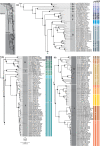Museomics of tree squirrels: a dense taxon sampling of mitogenomes reveals hidden diversity, phenotypic convergence, and the need of a taxonomic overhaul
- PMID: 32590930
- PMCID: PMC7320592
- DOI: 10.1186/s12862-020-01639-y
Museomics of tree squirrels: a dense taxon sampling of mitogenomes reveals hidden diversity, phenotypic convergence, and the need of a taxonomic overhaul
Abstract
Background: Tree squirrels (Sciuridae, Sciurini), in particular the highly diverse Neotropical lineages, are amongst the most rapidly diversifying branches of the mammal tree of life but also some of the least known. Negligence of this group by systematists is likely a product of the difficulties in assessing morphological informative traits and of the scarcity or unavailability of fresh tissue samples for DNA sequencing. The highly discrepant taxonomic arrangements are a consequence of the lack of phylogenies and the exclusive phenotypic-based classifications, which can be misleading in a group with conservative morphology. Here we used high-throughput sequencing and an unprecedented sampling of museum specimens to provide the first comprehensive phylogeny of tree squirrels, with a special emphasis on Neotropical taxa.
Results: We obtained complete or partial mitochondrial genomes from 232 historical and modern samples, representing 40 of the 43 currently recognized species of Sciurini. Our phylogenetic analyses-performed with datasets differing on levels of missing data and taxa under distinct analytical methods-strongly support the monophyly of Sciurini and consistently recovered 12 major clades within the tribe. We found evidence that the diversity of Neotropical tree squirrels is underestimated, with at least six lineages that represent taxa to be named or revalidated. Ancestral state reconstructions of number of upper premolars and number of mammae indicated that alternative conditions of both characters must have evolved multiple times throughout the evolutionary history of tree squirrels.
Conclusions: Complete mitogenomes were obtained from museum specimens as old as 120 years, reinforcing the potential of historical samples for phylogenetic inferences of elusive lineages of the tree of life. None of the taxonomic arrangements ever proposed for tree squirrels fully corresponded to our phylogenetic reconstruction, with only a few of the currently recognized genera recovered as monophyletic. By investigating the evolution of two morphological traits widely employed in the taxonomy of the group, we revealed that their homoplastic nature can help explain the incongruence between phylogenetic results and the classification schemes presented so far. Based on our phylogenetic results we suggest a tentative supraspecific taxonomic arrangement for Sciurini, employing 13 generic names used in previous taxonomic classifications.
Keywords: Historical DNA; Morphology; Neotropical region; Phylogeny; Sciuridae; Systematics.
Conflict of interest statement
The authors declare that they have no competing interests.
Figures






Similar articles
-
Evolutionary history of endemic Sulawesi squirrels constructed from UCEs and mitogenomes sequenced from museum specimens.BMC Evol Biol. 2016 Apr 14;16:80. doi: 10.1186/s12862-016-0650-z. BMC Evol Biol. 2016. PMID: 27075887 Free PMC article.
-
Complete mitogenomes of Turkish tree squirrels, Sciurus anomalus and S. vulgaris, (Sciuridae: Rodentia: Mammalia) and their phylogenetic status within the tribe Sciurini.Gene. 2022 Oct 20;841:146773. doi: 10.1016/j.gene.2022.146773. Epub 2022 Jul 26. Gene. 2022. PMID: 35905846
-
Old specimens for old branches: Assessing effects of sample age in resolving a rapid Neotropical radiation of squirrels.Mol Phylogenet Evol. 2022 Oct;175:107576. doi: 10.1016/j.ympev.2022.107576. Epub 2022 Jul 6. Mol Phylogenet Evol. 2022. PMID: 35809853
-
Understanding phylogenetic incongruence: lessons from phyllostomid bats.Biol Rev Camb Philos Soc. 2012 Nov;87(4):991-1024. doi: 10.1111/j.1469-185X.2012.00240.x. Epub 2012 Aug 14. Biol Rev Camb Philos Soc. 2012. PMID: 22891620 Free PMC article. Review.
-
Molluscan systematics: historical perspectives and the way ahead.Biol Rev Camb Philos Soc. 2025 Apr;100(2):672-697. doi: 10.1111/brv.13157. Epub 2024 Nov 6. Biol Rev Camb Philos Soc. 2025. PMID: 39505387 Review.
Cited by
-
Complete mitochondrial genome of the Galápagos sea lion, Zalophuswollebaeki (Carnivora, Otariidae): paratype specimen confirms separate species status.Zookeys. 2023 Jun 13;1166:307-313. doi: 10.3897/zookeys.1166.103247. eCollection 2023. Zookeys. 2023. PMID: 38328668 Free PMC article.
-
Integrative Taxonomy within Eremias multiocellata Complex (Sauria, Lacertidae) from the Western Part of Range: Evidence from Historical DNA.Genes (Basel). 2022 May 25;13(6):941. doi: 10.3390/genes13060941. Genes (Basel). 2022. PMID: 35741703 Free PMC article.
-
An evaluation of DNA extraction methods on historical and roadkill mammalian specimen.Sci Rep. 2023 Aug 11;13(1):13080. doi: 10.1038/s41598-023-39465-z. Sci Rep. 2023. PMID: 37567875 Free PMC article.
-
A draft genome assembly for the eastern fox squirrel, Sciurus niger.G3 (Bethesda). 2021 Dec 8;11(12):jkab315. doi: 10.1093/g3journal/jkab315. G3 (Bethesda). 2021. PMID: 34550334 Free PMC article.
-
First mitochondrial genome of the Caucasian squirrel Sciurus anomalus (Rodentia, Sciuridae).Mitochondrial DNA B Resour. 2021 Mar 15;6(3):883-885. doi: 10.1080/23802359.2021.1886012. Mitochondrial DNA B Resour. 2021. PMID: 33796667 Free PMC article.
References
-
- Thorington RW, Koprowski JL, Steele MA, Whatton J. Squirrels of the world. Baltimore: The Johns Hopkins University Press; 2012.
-
- Vivo M, Carmignotto AP, Family Sciuridae G . Fischer, 1817. In: Patton JL, Pardiñas UFJ, D’Elía G, editors. Mammals of South America, volume 2, rodents. Chicago and London: The University of Chicago Press; 2015. pp. 1–48.
-
- Burgin CJ, Colella JP, Kahn PL, Upham NS. How many species of mammals are there? J Mammal. 2018;99:1–14.
-
- Peres CA. The structure of nonvolant mammal communities in different Amazonian forest types. In: JF E, KH R, editors. Mammals of the Neotropics. Vol. 3. The central Neotropics: Ecuador, Peru, Bolivia, Brazil. Chicago and London: The University of Chicago Press; 1999. pp. 564–581.
-
- Mendes CP, Koprowski JL, Galetti M. NEOSQUIRREL: a data set of ecological knowledge on Neotropical squirrels. Mamm Rev. 2019;49:210–225.
Publication types
MeSH terms
Associated data
Grants and funding
- 147145/2016-3/Conselho Nacional de Desenvolvimento Científico e Tecnológico/International
- 203692/2017-9/Conselho Nacional de Desenvolvimento Científico e Tecnológico/International
- 165553/2017-0/Conselho Nacional de Desenvolvimento Científico e Tecnológico/International
- 304156/2019-1/Conselho Nacional de Desenvolvimento Científico e Tecnológico/International
- NGS-381R-18/National Geographic Society/International
LinkOut - more resources
Full Text Sources
Other Literature Sources

